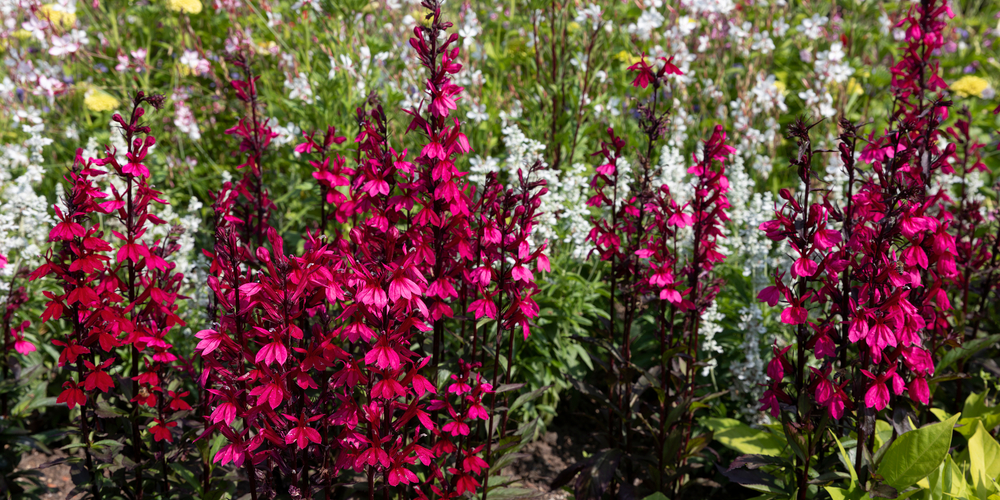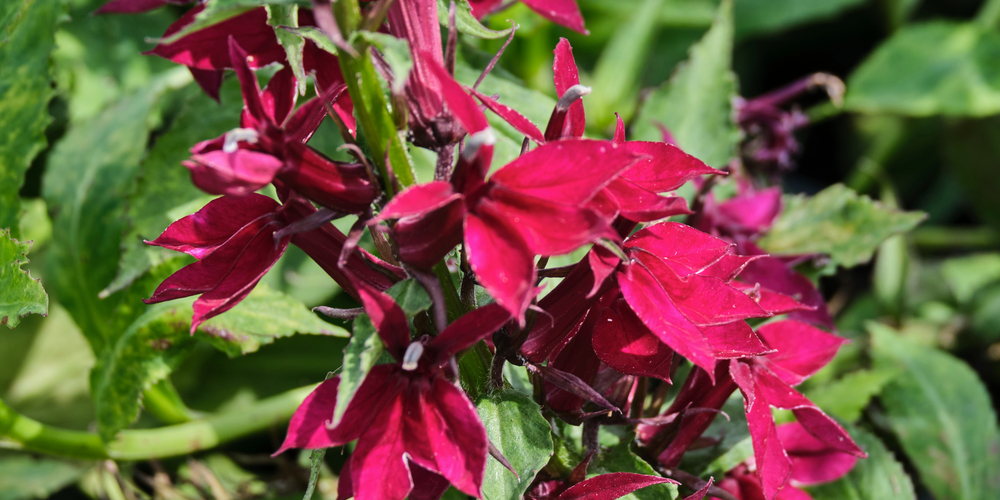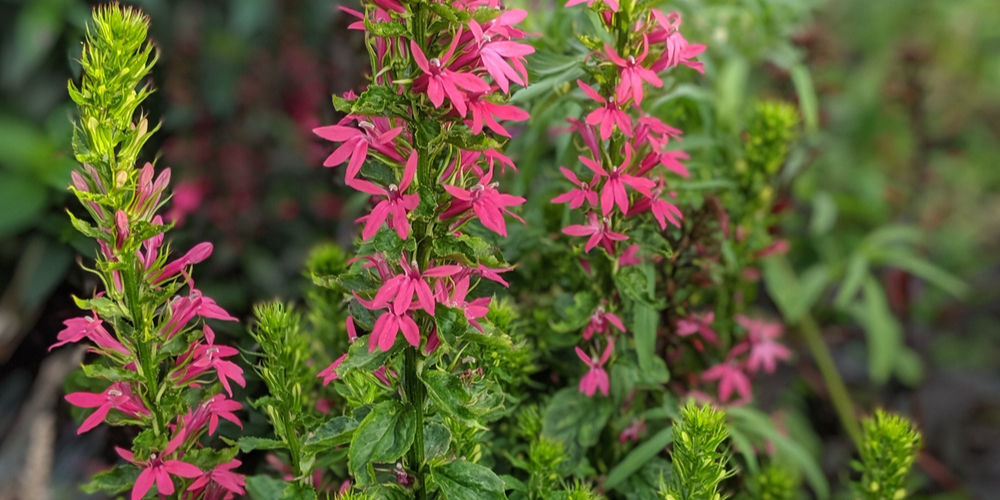The lobelia starship series features a significant improvement over other members of its family. This plant is characterized by flowers that blossom earlier with stronger branches.
| Scientific Name | Lobelia Starship |
| Plant Type | Perennial |
| Sun Requirements | Full Sun to Partial Shade |
| USDA Hardiness Zones | 6 to 10 |
| Soil PH Range | 5.8 to 6.5 |
| Soil Type | Slightly acidic, well-draining, and fertile |
| Water Needs | Medium to High |
There are three varieties in the lobelia starship series: the blue, deep rose, and scarlet bronze leaf. When grown together, they can make your garden look colorful while attracting butterflies and other pollinators.
The lobelia starship is a cultivar of the Kieft Seed and are a must-have plant in your garden. If you are considering growing lobelia starship, here is a comprehensive guide on taking care of it.
What You Need to Know about the Starship Lobelia
The starship lobelia is the kind of plant that draws everyone’s attention. As mentioned earlier, there are three varieties.
Lobelia starship deep rose – This herbaceous perennial is known for its eye-catching deep rose-pink flowers that bloom from midsummer to early fall. It also has a contrasting foliage of dark green leaves and black stems.
As a lobelia starship plant, the deep rose is celebrated by gardeners for its better branching. Because of its beauty, you can grow it in coastal and city gardens. Or near streams.
Lobelia starship blue – The next plant in this series is the lobelia starship blue. It produces unique violet-blue flowers that grow from upright flower spikes. The foliage color ranges from purple to green shades.
The lobelia starship blue blooms from mid-summer to early fall. It can grow well in a woodland shade or a rain garden.
Lobelia starship scarlet – Despite being the last starship series on our list, this plant also stands out with green foliage and scarlet-red flowers. It’s perfect for growing in pots and gardens. The lobelia starship scarlet’s blooms are butterfly-shaped and have an anise fragrance.
When you plant all three, you will turn your garden into a little piece of heaven. Besides the difference in physical characteristics, the lobelia starship series require the same growing conditions.
These plants are maintenance-free. Therefore, they can survive semi-hardy to frost areas. They aren’t very toxic when ingested but can cause some slight discomfort. You must wear gloves when handling them.
How to Care for the Lobelia Starship
Whether you plant all three varieties or one of them, here is a detailed guide on how to take of the lobelia starship.
Light
The lobelia family, in general, requires full sun to partial shade. That’s also the case for the lobelia starship series. However, if you grow it under full sun exposure, the soil must be kept moist.
If it’s being grown in a dry environment, some shade will be needed to prevent the plant from dehydration. Suppose you want to grow the lobelia starship as a houseplant.
Make sure you place it on a window and rotate it every once in a while. It would be best to give this flower at least five to six hours of sunlight.
Water and Soil Needs
For this flower to thrive, it should be planted in moist soils. They can do well in average moist soils, but the lobelia starships are water lovers. If you want to landscape around a stream, that would be the best place to grow them or in a rain garden.
Keep starships off standing water as it will lead to rotting of the roots. These plants also prefer a slightly acidic soil pH ranging from 5.8 to 6.5. A soil pH of less than seven should be just fine. Regarding the soil type, you should go with loam or clay.
Temperature Requirements
It can survive USDA climate zones 6 to 10. Also, it won’t dry up in heat zones 5 to 8. You can expect these flowers to bloom in early summer. In some cases, it can also be winterized.
Fertilizer
The lobelia starship has moderate fertilizer requirements. The best fertilizer for this plant should be water-soluble. This enables the plant to obtain as many nutrients as possible.
Nitrogen is one of the key ingredients needed for lobelia growth. Ensure that you stick to an application rating of 100 to 250 ppm of Nitrogen. Fertilizer is also needed during propagation. We will explain more when we get to that part.
Common Diseases
Unfortunately, the lobelia starship is vulnerable to some diseases. Examples include Sclerotinia, rust, leaf spots caused by Septoria, and Cercospora, which are types of fungus, and root rot.
These diseases can best be avoided by practicing proper irrigation and leaving enough space between plants. The latter plays a critical role in facilitating aeration.
Besides diseases, insects can also feed on lobelia starship and affect their growth. Common culprits include whiteflies, aphids, slugs, leafhoppers, snails, and leafminers.
Always be on the lookout for these insects and diseases. The sooner you spot them, the quicker you can treat or get rid of insects and diseases.
Propagation
The propagation of lobelia starship is more productive when you start with seeds. To increase the chances of germination and plant growth, the seeds are often pelleted. Here is a quick guide on propagating lobelia starships.
- You should start by planting the pelleted seeds. To be on the safe side, plant both small and big pellets.
- Ensure the seeds have access to direct light. Therefore, don’t cover them as that may interfere with the germination process.
- Retain soil moisture and ensure the soil temperature is about 65- to 75-degrees F. These conditions facilitate adequate humidity needed for germination.
- Ensure the above conditions remain constant for at least 7 to 10 days. That’s when germination will occur.
- Upon confirmation of germination, reduce the temperatures to between 60- and 65-degrees F. The soil must be allowed to dry out slightly.
- As soon as you spot sprouting leaves, add 100 ppm of Nitrogen fertilizer to the soil. This should be done during irrigation.
From there, you can wait for the propagated plants to grow. The first to reach a transplantable size out of the three variants will be the lobelia starship scarlet. That will occur in as less as seven weeks. The rose and the blue may take up to ten weeks.
Final Thoughts
These flowering perennials can grow up to 24 inches tall and 10 inches across. When you plant the three varieties, they will add a lot of color to your garden, no matter how small it is.
Because of the lobelia starship’s physical characteristics, these plants can be used for landscaping as long as the soil is moist. You can also grow them as indoor plants.
Related Article: Hot Snow White Lobelia Care Everything You Need to Know


